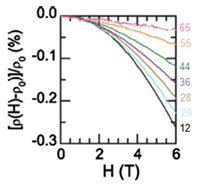|
|
Electrical transport and
magnetotransport properties of cuprates
 The
work in this field of research is being done as a
part of long-lasting collaboration with solid state
physics laboratory in Orsay, LPS (Laboratoire de
Physique des Solides, Universite Paris-Sud, Orsay,
France) and especially with dr Helene Raffy.
Experiments were conducted in LPS (dr H. Raffy, dr
Z.Z. Li, dr L. Fruchter and dr F. Bouquet) and also
in NHMFL in Grenoble, with the help of dr P. Monceau
and dr G. Reményi. The
work in this field of research is being done as a
part of long-lasting collaboration with solid state
physics laboratory in Orsay, LPS (Laboratoire de
Physique des Solides, Universite Paris-Sud, Orsay,
France) and especially with dr Helene Raffy.
Experiments were conducted in LPS (dr H. Raffy, dr
Z.Z. Li, dr L. Fruchter and dr F. Bouquet) and also
in NHMFL in Grenoble, with the help of dr P. Monceau
and dr G. Reményi.
Cuprates are copper-oxide-based materials with
laminar structure, with CuO2 layer as the main
component. Their properties strongly depend on
electric doping (hole and electron doping) and vary
so much that the cuprates can be normal metals,
antiferromagnetic insulators and even
superconductors with the highes critical
temperatures of all materials!
We studied experimentally electrical properties,
such as resistivity, critical current,
magnetoresistance and Hall effect, of epitaxial thin
films of electron-doped Sr1-xLaxCuO2, a cuprate with
the simplest structure and of hole-doped
Bi2Sr2Can-1CunOy, where n = 1 or 2.
The main published results for electron-doped
compound concern:
• Synthesis of the Sr1-xLaxCuO2 infinite layer
compound
• Magnetic field shifts superconducting transition
to lower T without significant broadening, similarly
to conventional superconductors
• The change of sign of Hall constant (existence of
two types of charge carriers with different
mobilities)
• Negative magnetoresistance in parallel magnetic
field, which is anisotropic (two- and fourfold
symmetric) when field rotates within CuO2 planes
(antiferromagnetic fluctuations which coexist with
superconductivity)
The results on hole-doped cuprates are in the
process of writing and concern
superconductor-to-insulator transition and
magnetoresistance in high magnetic fields.
Publications:
• V. P. Jovanović, Z. Z. Li and H. Raffy,
Superconducting properties, anisotropy and critical
currents of SrLaCuO e-doped epitaxial thin films,
Superconductor Science & Technology 24, 055002
(2011).
• L. Fruchter, V. Jovanović, H. Raffy, S. Labdi, F.
Bouquet, and Z. Z. Li, Penetration depth of
electron-doped infinite-layer Sr0.88La0.12CuO2+x
thin films, Physical Review B 82, 144529 (2010).
• V. P. Jovanović, L. Fruchter, Z. Z. Li and H.
Raffy, Anisotropy of the in-plane angular
magnetoresistance of electron-doped Sr1-xLaxCuO2
thin films, Physical Review B 81, 134520 (2010).
• V. P. Jovanović, Z. Z. Li, H. Raffy, J. Briatico,
A. A. Sinchenko and P. Monceau, Resistive upper
critical fields and anisotropy of an electron-doped
infinite-layer cuprate, Physical Review B 80, 024501
(2009).
• Z. Z. Li, V. Jovanovic, H. Raffy and S. Megtert,
Influence of oxygen reduction on the structural and
electronic properties of electron-doped Sr1-xLaxCuO2
thin films, Physica C  469, 73 (2009). 469, 73 (2009).
• Z. Z. Li , F. Bouquet, L. Fruchter and H. Raffy,
Magnetoresistance and
Hall effect in e-doped superconducting SrLaCuO thin
films, V. Jovanović, Journal of Physics: Conference
Series 150, 052086 (2009).
Figure 1: Temperature dependence of Hall constant of
two Sr0.88La0.12CuO2+x thin films that differ in
electron doping (oxygen content). Curves cross zero
which implies the existence of two types of charge
carriers with different mobilities.

Figure
2: The shift of superconducting transition of
Sr0.88La0.12CuO2 thin film in parallel magnetic
field.


Figure 3: Left: Negative
magnetoresistance of Sr0.88La0.12CuO2 thin film in
parallel field at temperatures indicated. Right:
Anisotropy of the magnetoresistance in 6 T when the
magnetic field rotates within CuO2 plane.
Organic quasi-2D superconductors
Some unconventional superconductors, such as heavy
fermions, high Tc cuprates, borocarbide and organic
superconductors follow so called Uemura trend – the
proportionality between critical temperature and
density of superconducting electrons. The question
of the mechanism that leads to their
superconductivity is still open, and studying one of
the above mentioned compounds might give some idea
about the mechanism of the others.
We studied theoretically some physical properties
that depend on the order parameter symmetry of
organic quasi-2D superconductors, κ-(ET)2X
salts, which have many similarities with cuprates,
particularly in structure and the vicinity of
antiferromagnetic and superconducting region in the
phase diagram. We obtained results for the
electronic density of states, specific heat, spin
susceptibility, magnetic penetration depth and
tunneling conductance for three types of order
parameter symmetry (d-wave, and dxy-like extended-s)
of κ-(ET)2X salts with an elliptical
Fermi surface by using generalized BCS theory
without impurities.
Publications:
• L. Dobrosavljević-Grujić, V. Jovanović and R.
Zikic, Superfluid density and pairing in planar
organic superconductors, Physica C 432, 140 (2005).
• V. Jovanović, R. Zikic and L.
Dobrosavljević-Grujić, Pairing in planar organic
superconductors, Physica C 423, 15 (2005).

Figure 1: Fermi surface (a) and polar plots of the
superconducting gap functions: (b) d-wave, (c)
dxy-like wave, and (d) extended s-wave.

Figure
2: Temperature dependence of the order parameter for
three types of unconventional pairing: d-wave,
dxy-like and extended s-wave. Full line represent an
approximation to classical BCS parameter Δ(T)/Δ(0) =
tanh[1.74√√(Tc/T – 1)]. |